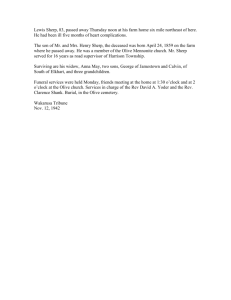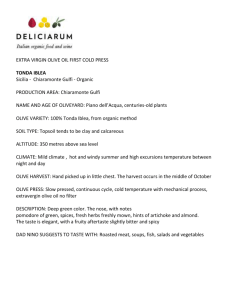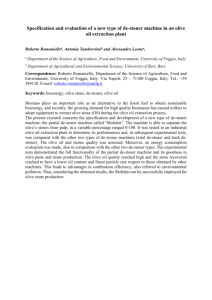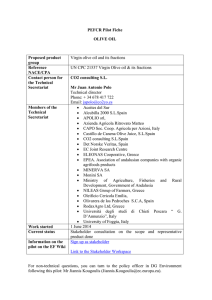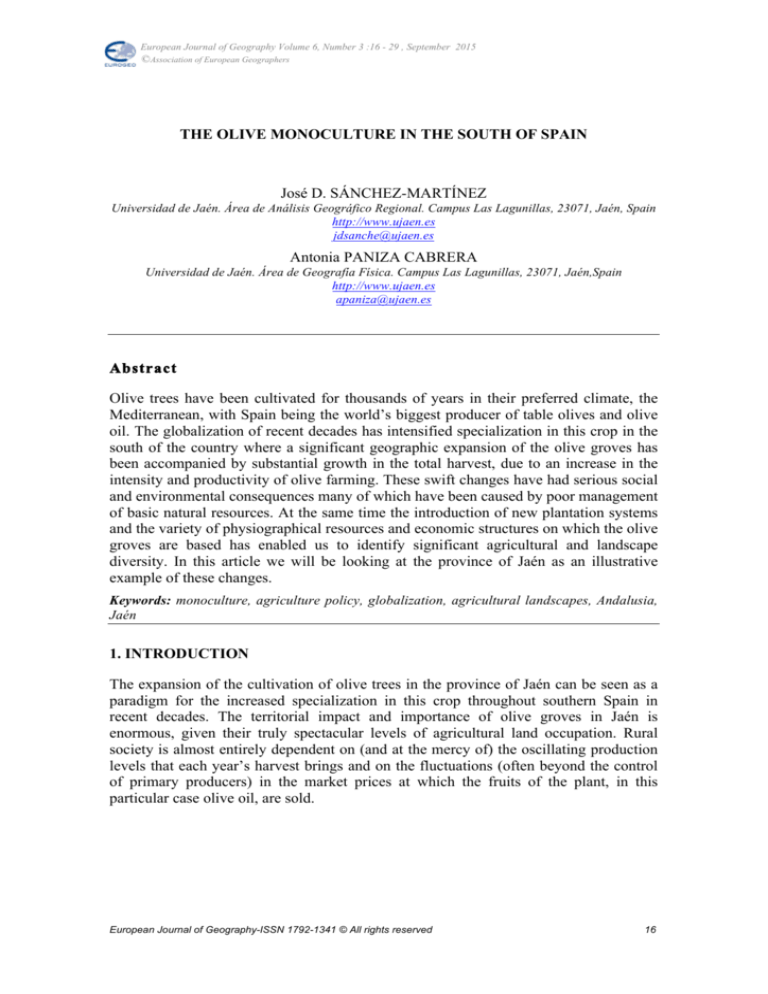
European Journal of Geography Volume 6, Number 3 :16 - 29 , September 2015
©Association of European Geographers
THE OLIVE MONOCULTURE IN THE SOUTH OF SPAIN
José D. SÁNCHEZ-MARTÍNEZ
Universidad de Jaén. Área de Análisis Geográfico Regional. Campus Las Lagunillas, 23071, Jaén, Spain
http://www.ujaen.es
jdsanche@ujaen.es
Antonia PANIZA CABRERA
Universidad de Jaén. Área de Geografía Física. Campus Las Lagunillas, 23071, Jaén,Spain
http://www.ujaen.es
apaniza@ujaen.es
Abstract
Olive trees have been cultivated for thousands of years in their preferred climate, the
Mediterranean, with Spain being the world’s biggest producer of table olives and olive
oil. The globalization of recent decades has intensified specialization in this crop in the
south of the country where a significant geographic expansion of the olive groves has
been accompanied by substantial growth in the total harvest, due to an increase in the
intensity and productivity of olive farming. These swift changes have had serious social
and environmental consequences many of which have been caused by poor management
of basic natural resources. At the same time the introduction of new plantation systems
and the variety of physiographical resources and economic structures on which the olive
groves are based has enabled us to identify significant agricultural and landscape
diversity. In this article we will be looking at the province of Jaén as an illustrative
example of these changes.
Keywords: monoculture, agriculture policy, globalization, agricultural landscapes, Andalusia,
Jaén
1. INTRODUCTION
The expansion of the cultivation of olive trees in the province of Jaén can be seen as a
paradigm for the increased specialization in this crop throughout southern Spain in
recent decades. The territorial impact and importance of olive groves in Jaén is
enormous, given their truly spectacular levels of agricultural land occupation. Rural
society is almost entirely dependent on (and at the mercy of) the oscillating production
levels that each year’s harvest brings and on the fluctuations (often beyond the control
of primary producers) in the market prices at which the fruits of the plant, in this
particular case olive oil, are sold.
European Journal of Geography-ISSN 1792-1341 © All rights reserved
16
Sanchez Martinez D. J. & Paniza Cabrera A. / European Journal of Geography 6 3 16–29 (2015)
Table 1. Importance of the monoculture of olive trees in the province of Jaén in terms of surface
area (ha)
Jaén
Andalusia
Spain
%
(x)
(y)
(z)
(x/y)
Geographic area (a)
1,349,810
8,738,052
50,536,508
15.45
Agricultural land (b)
641,774
3,543,456
17,076,195
18.11
Area planted with olives (c)
584,415
1,542,640
2,504,261
37.88
% (b/a)
43.30
40.55
33.77
-% (c/b)
91.06
43.53
14.67
-Sources: Avance Anuario de Estadística Agraria 2013; http://www.magrama.gob.es
Informe anual del sector agrario en Andalucía 2012; https://www.obrasocialunicaja.es
Avance de superficie y producciones agosto 2014; http://www.juntadeandalucia.es
%
(y/z)
17.29
20.75
61.60
---
The information set out in Table 1 shows that this is indeed an extreme case of
monoculture with over 91% of agricultural land occupied by this single plant, forming a
huge swathe of green that extends across neighbouring provinces, making it one of the
highest concentrations of tree crops in the whole of the European Union.
Figure 1. Distribution of olive groves in southern Spain, 2007
23% of Spain's olive groves and almost 38% of those in Andalusia are concentrated
in the province of Jaén. In years with favourable weather conditions, olive oil
production in the province is similar to that of the world's second and third largest
producers, Italy and Greece, added together (IOC, 2014, Regional Government of
Andalusia, 2014). The olives harvested in the groves of Jaén are used almost
exclusively for making olive oil, and the picual variety of olive is almost ubiquitous due
European Journal of Geography-ISSN 1792-1341 © All rights reserved
17
Sanchez Martinez D. J. & Paniza Cabrera A. / European Journal of Geography 6 3 16–29 (2015)
to its excellent results and the stability and quality of the oil extracted from it. The result
is that within Jaén’s agricultural monoculture there is also a high concentration in a
single variety and with a single purpose. This concentration is just one more of a set of
strategies implemented by a production sector in which producers compete by cutting
costs as far as possible. This causes various logistical problems in that almost all the
fruit reaches optimum levels of ripeness at the same time, with small differences in
altitude being the only means of staggering the process to facilitate the organization of
the harvest and the pressing of the fruit. The olives are normally pressed in cooperative
olive mills with a large processing capacity, despite which the harvest periods almost
inevitably extend beyond the ideal period in which the highest possible quality of the oil
is ensured. As a result the oil for human consumption is graded according to quality into
three main types, namely extra virgin, virgin and lampante in decreasing quality and
price order.
Another interesting recent trend is the increasingly widespread use of irrigation.
Traditionally the olive was considered a non-irrigated (secano) crop, which, like the
other perennial plants so dominant in Mediterranean agriculture, had deep root systems
that could withstand the severe hydric stress suffered by plants during the long, hot, dry
summers in this part of the world. Traditionally irrigation was only used in mountain
areas with springs or in vegetable gardens with a few olive trees. Nowadays however as
a result of this excessive specialization in a single crop, a significant proportion of the
olive groves of Jaén are irrigated, such that half of Spain’s irrigated olive groves for oil
production are located in the province (Ministry of Agriculture, Food and the
Environment, 2014). Mainly, they are irrigated by trickle systems with an average of
1500 m3/ha.
The geographical and environmental conditions for growing olive trees are in general
quite favourable on most agricultural land (Ministry of Agriculture, 1975), however it is
clear that government promotion of certain crops (in particular as a result of Spain
joining the European Economic Community, which at that time had a number of
important market intervention mechanisms), and trends in the market itself (although in
the last two years the prices received by farmers have stagnated at low levels) have
intensified this process. Indeed the output levels obtained in the province on both nonirrigated and irrigated land are above both the regional and national averages (Sánchez
and Gallego, 2011). This does not prevent however important contrasts in terms of
production and performance within the province, in which the most productive olive
groves can produce up to 20 times more per hectare of land than their least efficient
counterparts. Despite their low output these uneconomic olive groves are often
maintained even though on many occasions they were initially cultivated by ploughing
up woodland or forest, something which should never have been allowed to happen.
In spite of all this, today’s farmers, who sell their produce above all in the intraindustrial market, are trapped inside a production and distribution system that restricts
their capacity to participate in the added value chain (Delgado Cabeza, 2014). Another
unusual feature of this monoculture is that it is based on a small-scale land ownership
structure, which means that a large number of farms are not managed by professional
farmers. In addition the serious consequences of this intensive agriculture model in
environmental terms, many of which were caused by the productivity-oriented
application of the Common Agricultural Policy (CAP) have yet to be resolved, above all
in the case of soil erosion (Beaufoy, 2001). This brings us to the strange paradox that
despite having acknowledged benefits for our health, olive oil is based on a clearly
unsustainable model of production (Scheidel and Krausmann, 2011).
European Journal of Geography-ISSN 1792-1341 © All rights reserved
18
Sanchez Martinez D. J. & Paniza Cabrera A. / European Journal of Geography 6 3 16–29 (2015)
In the next sections we will be explaining how and where the expansion of the olive
groves has been taking place; in what way the production levels have been increased,
what effects these changes have had and what landscape and agricultural diversity can
be identified in the midst of this monoculture.
2. THE GEOGRAPHICAL EXPANSION OF OLIVE FARMING
Although there are evident differences in many fundamental aspects between the olive
grove and other monocultures around the world, certain common patterns can be
identified in their spread and development. The expansion of soya and other plantation
crops in South America could be a useful point of reference (Fernandes, Welch and
Gonçalves, 2012). In South America as in Spain for example, there has been a move
towards large-scale production and a reduction in the number of stakeholders involved
in the value chain. New formulas of conservative modernization (green revolution) have
also been tested. These are based on increasing harvests, reducing labour costs and
externalizing the least desirable effects of the production process. Another shared
pattern worth noting is the conflictive coexistence of farms with hugely different levels
of return: in the case of tropical plantations this is the result above all of the relative size
of the farms, while in the olive groves of Andalusia it is due also to varying cultivation
methods.
Although this is hardly a ground-breaking revelation, the reason why these
similarities occur between such diverse crops and continents is the advance of the
neoliberal-inspired globalization process. Put very simply and elegantly “one way of
looking at globalization is to view it as a process in which the distances covered by
materials, goods and people increase in order to resolve needs that could be sorted out at
a local level without additional ecological and social costs” (Cembranos Díaz, 2011). In
its broadest sense globalization involves the restructuring of capital to enable it to act at
a worldwide level, something that has become possible with the deregulation of
financial markets, the liberalization of trade and the boost to business activity produced
by productive and technological innovation (Bernstein, 2011). These initiatives
inevitably increase the trend towards monocultures and are a good context in which to
understand what has happened in the case being analysed here.
Figure 2 shows the gradual spread of the area occupied by olive groves since reliable
data on this question became available. This is a continuous process which has been
happening throughout modern times at a more or less constant rate with occasional
peaks of activity produced by particularly favourable circumstances (Zambrana Pineda,
1987). It is also interesting to note that this expansion hardly declined at times when
circumstances were not so favourable. During these lean periods the olive farmers tried
to overcome the repeated crises with which they have had to cope by adapting and
applying different strategies which we will later go on to examine.
European Journal of Geography-ISSN 1792-1341 © All rights reserved
19
Sanchez Martinez D. J. & Paniza Cabrera A. / European Journal of Geography 6 3 16–29 (2015)
700000
600000
500000
400000
300000
200000
100000
0
1752
1879
1935
1956
1970
1986
1999
2009
2014
Figure 2. Increase in the area planted with olive groves (ha) in the province of Jaén (1752-2014)
Previous researchers observed certain spatial patterns for this expansion in the
surface area (Sánchez & Galiano, 2014). In short until the mid-20th century the
preferred location for olive groves was on land with low agricultural capacity.
Throughout this whole period total harvests increased due above all to geographic
expansion than to other reasons. This does not mean that there were no olive farms on
good or even excellent soils, but the norm was for this land to be used for cereal
production for its higher profitability. This situation however changed drastically from
the second half of the 20th century onwards (see Figure 3 and Table 2), when Spanish
agriculture became increasingly market-orientated and above all when Spain joined the
European Economic Community (1986).
Figure 3. Distribution of the olive grove in the province of Jaén in 2007 according to agricultural land
quality (*)
(*) The areas in white on the northern, eastern and southern fringes of the province are mountain areas
used for forestry in which agriculture is impossible.
European Journal of Geography-ISSN 1792-1341 © All rights reserved
20
Sanchez Martinez D. J. & Paniza Cabrera A. / European Journal of Geography 6 3 16–29 (2015)
By analysing the changes in land use between 1957 and 2007, a period in which the
area covered by olive groves grew by over 60% (about 215,000 ha), we have identified
the agricultural landscapes that have succumbed to this green tsunami sweeping across
the country. In most cases olive trees were planted on non-irrigated land that had
previously been used for cereal production. In other cases, expansion occurred by
ploughing up land that had been used for livestock (scrub, pasture and even wooded
areas). One would have expected that land of this kind would have been gradually
abandoned, given the difficulties in working it for agriculture and the economic changes
taking place in the agrarian economy at that time, and would have reverted to a more
natural state without direct human intervention. At most, it could have been maintained
for extensive livestock use. Spain’s joining the EEC in 1986 changed deeply everything.
The subsidies that began to flow from Brussels acted as strong incentives for steering
agricultural production to a particular crop or type of farming to the detriment of others.
They also enabled olive groves in agriculturally marginal areas to be maintained and led
other complex agrarian landscapes such as several dehesas to be planted with olive trees.
Fields around villages traditionally used for vegetable gardens were also often converted
into olive groves. Another trend that we noted during this period is that the traditional
association of olive trees with other herbaceous or woody crops (vines, almonds, fruit
trees etc) has virtually disappeared. Diversified agriculture of this kind is apparently no
longer viable in the context of increasing specialization, in which Spanish agriculture has
come to focus exclusively on the market, a process that has coincided with a huge exodus
from rural areas.
As we mentioned earlier, these changes also coincided with the progressive
encroachment of olive groves onto the land with the best agronomic conditions. If we
superimpose the areas covered by olive groves in 1957 and 2007 onto a map in which
land is classified according to its capacity for agricultural production (excellent, good,
moderate and low or marginal), we find that although expansion was indeed generalized,
there was less growth on land with less natural fertility, so changing the traditional
scenario in which olives were normally planted on poorer soil.
Table 2.
Changes in the area occupied by olive groves in relation to land use capacity
Province of Jaén
Olive Grove 1957
Olive Grove 2007
Δ 1956-2007
Type
Area (ha)
(%)
Area (ha)
(%)
Area (ha)
(%)
Area (ha)
(%)
Excellent
24,015.41
1.78
5,055.70
21.05
8,324.89
1.46
3,269.19
64.66
Good
279,749.86
20.76 126,527.30 45.23 218,242.00 38.24
91,984.70
72.85
Moderate 375,488.14
27.86 105,068.96 27.98 183,274.00 32.12
78,205.04
74.43
Marginal
668,306.20
49.59 118,996.56 17.81 160,814.00 28.18
41,817.44
35.14
Total
1,347,559.62 100.00 335,378.52 24.89 570,654.89 100.00 215,276.37 60.58
Source: REDIAM, http://www.juntadeandalucia.es/medioambiente/site/rediam (accessed 10 April 2015).
3. THE INCREASE IN PRODUCTION
Olive production in Andalusia on both irrigated and non-irrigated land has increased by
around 4% a year over the last 40 years. This rise is due to the increase in intensity
(fertilization and irrigation) and productivity (increased density of plantation and
improved care). In the 1950s and 60s the only effective way of increasing harvests was
to increase the area under cultivation, however this began to change in the 1970s when a
genuine productive revolution began (Berbel and Giannocaro 2013). Instead of the
traditional plantations on non-irrigated land with a capacity of about 80 trees per
hectare, the new olive groves were generally irrigated and much more intensive (with
practically twice the number of trees or the same piece of land), with the most modern
European Journal of Geography-ISSN 1792-1341 © All rights reserved
21
Sanchez Martinez D. J. & Paniza Cabrera A. / European Journal of Geography 6 3 16–29 (2015)
being laid out in hedge formation with up to 1500 plants per hectare. These intensive
plantation systems can only be found in recently planted groves, although many
traditional olive groves have also been made denser with new trees filling in gaps. As a
result the current average in the region is 130 trees per hectare (Regional Ministry of
Agriculture, Fishing and Rural Development, 2015).
Irrigated land now accounts for half of all the olives produced in Andalusia. This is
because as well as increasing production, irrigation makes it more stable, in that in years
with adverse weather conditions, such as drought, irrigated olive groves achieve
significantly higher harvests than those obtained in non-irrigated fields. This happened
because at least until 2006 olive trees were the best option in economic terms for both
non-irrigated land and irrigated land compared with the other possible alternatives and
they still are today for intensive farming on irrigated land (Berbel and Giannocaro,
2013). An easy way of demonstrating this fact is to study land prices over this period, in
which olive groves (both on non-irrigated and irrigated land) have always performed
much better than the weighted average for all the different crops as a whole, particularly
when compared to the other two crops with which olives have traditionally competed,
namely vineyards and cereals (Regional Government of Andalusia, 2013).
All these figures and trends are even more pronounced in the province of Jaén. While
in 1970 only 7.35% of olive groves in the province were irrigated, by 2012 this figure
had jumped to 46.8%. Almost half of the province’s olive groves therefore have access
to sufficient water supply or at least benefit from what is known as “deficit irrigation”.
This is land which receives less than the optimum annual amount of water (around
1,500 m3/ha/year), but receives some irrigation at certain precise moments during the
year to make a significant difference compared to olives growing on non-irrigated land
(Pastor, Vega & Hidalgo, 2005). Another spectacular change is the rapid growth in
recent years of a process in which irrigated land that was hitherto unregulated by the
administration has been given official sanction. This began in the mid-1990s, a period
of sustained drought, and has gathered pace more recently in statistical terms, such that
over 80,000 new hectares of irrigated land appeared in the statistics for 2012.
The growth in harvests, oil production and the increasing role of more intensive olive
groves (as represented by irrigated olive groves) is presented in Figure 4 and Table 3.
The graph in Figure 4 shows that production has increased much more than the amount
of land occupied by olive groves and illustrates perfectly the varying annual output of a
crop that is very sensitive to the amount of rainfall it receives during the winter. It is
very easy therefore to identify the drought periods that occurred at the beginning of the
1980s and from 1992 to 1995, as well as periods of optimum meteorological conditions
which led to bumper harvests such as that of 2003, which was 6.3 times the minimum
harvested in 1995.
European Journal of Geography-ISSN 1792-1341 © All rights reserved
22
Sanchez Martinez D. J. & Paniza Cabrera A. / European Journal of Geography 6 3 16–29 (2015)
700000
600000
500000
400000
300000
200000
2010
2009
2008
2007
2006
2005
2004
2003
2002
2001
2000
1999
1998
1997
1996
1995
1994
1993
1992
1991
1990
1989
1988
1987
1986
1985
1984
1983
1982
1981
1980
1979
1978
1977
1976
1975
1974
1973
1972
1971
0
1970
100000
Figure 4. Total virgin olive oil (tn) production in the province of Jaén, 1970-2012
In order to avoid the distortions produced by the high variations in production
resulting from the different annual weather conditions in Table 3 we have calculated the
average for the last four 10-year periods for which we have reliable data. As we can see,
the production of virgin olive oil has increased continuously with the figure for the last
decade being 2.85 times higher than that for the first one. We can also chart the
increasing amount of olives produced in irrigated groves as a proportion of the total
harvest, which rose from an average percentage of 16% in the 1990s to more than 43%
in the last decade.
Table 3.
Average production of virgin olive oil by decades, 1973-2012
Ten-year
Production on non-irrigated land
Production on irrigated land
Total
period
Tn
Tn
%
Tn
%
1973-1982
139,109
84.63
25,273
15.37
164,382
1983-1992
186,707
84.00
35,574
16.00
222,281
1993-2002
241,165
71.86
94,417
28.14
335,582
2003-2012
263,214
56.13
205,746
43.87
468,960
Source: Anuario de Estadística Agraria. Ministerio de Agricultura, Alimentación y Medio Ambiente.
http://www.magrama.gob.es/es/estadistica/temas/publicaciones/anuario-de-estadistica/
As mentioned earlier, the continuing success and growth of olive farming was
reflected in the price of land. Farms with olive groves in the province of Jaén have
always been more expensive than the average for Andalucia as a whole and for Spain.
For example in 2013 the price for 1 ha of irrigated olive grove was €44,500 while
purchasers of a hectare of non-irrigated olive grove would have had to pay €26,000.
These figures were in any case substantially lower than the maximum observed some
years earlier when speculation drove prices to levels that were out of step with the real
value of the farms. It is evident however (see Figure 5) that since the bursting of the
building bubble and the generalized spread of the economic crisis in Spain (2008) there
has been a progressive decline in these prices.
European Journal of Geography-ISSN 1792-1341 © All rights reserved
23
Sanchez Martinez D. J. & Paniza Cabrera A. / European Journal of Geography 6 3 16–29 (2015)
70000
60000
50000
40000
30000
20000
10000
0
2005 2006 2007 Non-irrigated olive groves
2008 2009 2010 Irrigated olive groves
2011 2012 2013 Average price of land
Figure 5. Prices of olive groves (€/ha) in the province of Jaén, 2005-2013
4. AGRONOMIC AND LANDSCAPE DIVERSITY
The massive occupation of agricultural land by the olive groves does not disguise the
fact that farms of very diverse kinds continue to coexist. This is due mainly to the fact
that olives have been planted on land of very varying quality in terms of agricultural
potential, one of the reasons also for the high variation in output per hectare. If we look
at Table 2, we can see that in spite of the shift towards land with better soils, the olive
groves planted on soils with limitations (moderate and marginal capacity) still account
for over 60% of the total.
The structure of land ownership is also wide-ranging. Olives have traditionally been
grown on small farms and, despite the increasing monoculture, this remains true today
in which the average farm size is 4 hectares. 92% of farms have less than 10 ha and
these represent 56.6% of the total area. By contrast only 2.8% of the farms have more
than 20 ha although these account for 21.6% of the total area. Large estates (those above
the 100 hectare threshold) are very few and far between, accounting for only 0.21% of
the farms and 6% of the total area (Sánchez, Gallego and Araque, 2011). All these
figures show that despite intensification olive farming remains a predominantly family
business and even a part-time form of agriculture.
The cultivation systems are also very varied. There are two main models:
•
•
Traditional olive groves with broadly spaced trees (80-120 trees/ha), on nonirrigated land, with medium or low harvest performance (from 2,000 to 4,000 kg
of olives/year), with trees that are always over 25 years old. In this category it is
important to distinguish between the olive groves that are planted on a slope of
more than 20%, above which it is impossible to mechanize all the related
farming tasks. These groves are referred to as “olivares de sierra” (mountain
olive groves).
Densely planted olive groves normally on gently sloping or flat land that is
completely mechanized and irrigated, thereby obtaining high levels of
production (from 8,000 to 12,000 kg of olives/year). Within this category we can
distinguish between intensive olive groves (200-600 plants/ha) and super
intensive or cane-trained olive groves (1,000 to 2,000 plants/ha).
European Journal of Geography-ISSN 1792-1341 © All rights reserved
24
Sanchez Martinez D. J. & Paniza Cabrera A. / European Journal of Geography 6 3 16–29 (2015)
A third category could be added with those farms which have opted for ecological
methods of farming. This option has however not proved very popular in the province.
At present Jaén has only 7,000 of the 58,000 ha in Andalusia as a whole. So far the only
appreciable advance in this direction is the increase in so-called integrated production
groups. Under this system farmers can continue to use conventional chemical products,
but only in appropriate quantities and with technical advice, so preventing the abuse that
until recently was so common.
The cultivation systems therefore also have extremes ranging from complete
ecological and economic marginality (olive groves which occupy land once covered by
forest with very poor soil or topographically very steep or uneven land with outputs of
around 500 kg/ha), which are not profitable even when the different CAP subsidies are
taken into account; to the most modern intensive systems of production in which the
olives are planted in continuous lines of bushes or hedges which can be harvested
mechanically and quickly at the optimum moment of ripeness of the fruit. In these
intensive groves record production levels of 17,000 kg/ha can be obtained, making them
profitable even if government subsidies were to come to an end. This means that a
hectare of super-intensively farmed olive grove can produce 30 times more than a
marginal olive grove (in economic terms the difference is even greater as mechanization
significantly reduces the cost of harvesting, the most expensive part of olive farming).
Photos 1 and 2. Contrast between super-intensive and mountain olive groves
Most farms however operate at mid-range production levels and their survival
depends both on market prices for olive oil and on the institutional support they receive.
It is important to remember nonetheless that almost 70% of farms in Andalusia produce
less than 4000 kg of olives per year (Regional Government of Andalusia, 2008).
In the case of the province of Jaén, taking into account the age of the trees, the
cultivation system, the planting density and the slope of the land, 16 different types of
olive groves can be identified, of which the most dominant are traditional plantations of
adult trees on non-irrigated land (66.89% of the farms and 59.89% of the area). By
contrast, the most intensive farms form an almost negligible fraction. Various categories
have been grouped together (Figure 6) in order to analyse the economic viability of
olive farms in the present context of stagnant low prices that has affected recent
harvests (Economic and Social Council of the Province of Jaén, 2011).
According to this study, when the price at source is around 1.75 €/Kg, the norm in
recent years, 97.95% of the total cultivated area and 99.47% of the farms are selling
their olives at below production cost price, although when EU subsidies are taken into
account this figure is reduced by about half. In any case what is clear is that only the
European Journal of Geography-ISSN 1792-1341 © All rights reserved
25
Sanchez Martinez D. J. & Paniza Cabrera A. / European Journal of Geography 6 3 16–29 (2015)
most intensive forms of production, which are the least common (Figure 6), can
withstand adverse market situations and the reduction in subsidies resulting from the
application of the recently modified CAP.
OI*
11,291
OTMR*
132,854
OTMS*
186,536
OTDM*
220,510
000
50,000
100,000
150,000
200,000
250,000
Figure 6. Area (ha) occupied by the different forms of olive production in the province of Jaén(*)
OTDM: Traditional olive grove difficult to mechanize. OTMS: Traditional mechanizable olive grove on
non-irrigated land. OTMR: Traditional mechanizable olive grove on irrigated land. OI: Intensive olive
grove.
5. CONCLUSION
The olive groves of Jaén are the quintessential example of agricultural monoculture in
southern Spain. In their expansion across the province, olive producers have adapted to
changing circumstances in different ways by setting up cooperatives for the
transformation of the olives into oil (Hernández, 1999), incorporating new machinery
(Parejo and Zambrana, 1994), inorganic fertilizers and irrigation (Garrido, 2004),
changes that have become generalized over the last 20 years (Sánchez et al., 2009),
albeit gradually and always with the aim of increasing harvests and reducing production
costs. This has enabled the province to become the world leader in olive oil output
(Rodríguez and Parras, 2011), most of which is sold in bulk rather than being bottled
and distributed by local producers. The fact that producers depend on distribution
channels that they do not control together with an increasing supply of oil on the world
market has led to the fall in prices observed in recent years. There is also increased
awareness of other problems related to this model of production, such as the nonsustainability of some of the farming practices which have led in particular to serious
problems with soil erosion and increased demand for water.
We are currently immersed in a period of institutional changes in a sector that is
trying to adapt to this new environment. Various options are being considered such as
the abandonment of less profitable farms, the intensification of those best suited to
compete in terms of increasing harvests/reducing costs, diversification of activities
within farms (olive oil tourism, use of biomass waste products for energy production
and agricultural supplies), the formation of producer-controlled distribution channels
etc.
As regards this last option, the essential condition is that part of the harvest be set
aside for making oils of the highest quality, so breaking with a tradition in which too
often quantity was more important than quality. The government has been working in
this direction for over three decades but it was not until bulk oil prices slumped to
below cost price that the message really began to sink in amongst many producers.
Initial steps in this direction involved the setting up of protected designations of origin
European Journal of Geography-ISSN 1792-1341 © All rights reserved
26
Sanchez Martinez D. J. & Paniza Cabrera A. / European Journal of Geography 6 3 16–29 (2015)
(PDO), although these initiatives have met with only limited success (Sanz and Macías,
2005) in the selected areas, which cover a total of 140,000 ha. As mentioned earlier, the
strategy of promoting ecological olive oil has not proved particularly successful either,
in spite of the fact that experience has shown that a sufficient price differential can be
obtained to offset the additional costs arising from ecological production (Barea and
Ruiz, 2002).
Instead in recent years numerous producers have emerged, who are opting for top of
the range extra-virgin oil which they bottle and distribute at source. The decisive move
towards a product of this kind requires an almost revolutionary transformation of the
customs and attitudes of producers, which begins with the work on the farm itself. In
fact perhaps the most important change required in this form of production is bringing
forward the olive picking season by almost two months (from December to October) to
a time in which the fruit is not fully ripe. At this point the olive’s organoleptic qualities
are at their peak, although output in terms of oil volume is lower. These oils, which
have won many awards in national and international competitions and are now highly
regarded on the market, are at the opposite end of the spectrum to the traditional
strategy of bulk sale and fit much better with the idea of olive oil as a quality product
that is beneficial for health. As this philosophy spreads the production of high quality
olive oils can bring about change at all levels and stages of the business process from
the care of the plant to the harvesting process, from the training of employees to the
development of locally-controlled distribution and internationalization strategies
(Rodríguez, Sánchez and Gallego, 2013). This would be a good start towards harnessing
all the potential of the province in an ambitious programme of endogenous
development.
ACKNOWLEDGEMENTS
This research is part of a wider research project entitled “Characterization and
perspectives of the olive monoculture in Jaén: its spatial and chronological formation,
landscape-agronomic diversity and immediate territorial dynamics”, which is funded by
the Ministry of Economy, Innovation and Science of the Regional Government of
Andalusia (SEJ – 1153, call 2012).
REFERENCES
Beaufoy, G. 2001. The environmental impact of olive oil production in the European
Union: practical options for improving the environmental impact.
http://ec.europa.eu/environment/agriculture/pdf/oliveoil.pdf (accessed 13 January
2008).
Barea, F. & Ruiz-Avilés, P. 2002. Olivar ecológico en zonas de montaña andaluzas.
Evolución y pers- pectivas”. http://www.premiobiol-it/osservatorio (accessed 14
April 2015
Berbel Vecino, J. & Giannocaro, G. 2013. Economía de los olivares en Andalucía. In
VV. AA.: Andalucía. El olivar. Sevilla. Grupo de Estudios Avanzados sobre
Territorio y Medio Ambiente. 133-146.
Bernstein, H. 2011. A dinâmica de classe do desenvolvimento agrário na era da
globalização. Sociologias, 27: 52-81.
Cembranos Díaz, F. 2011. Pérdidas que hacen crecer el PIB.
http://www.rebelion.org/noticia.php?id=110528 (accessed 30 January 2012).
European Journal of Geography-ISSN 1792-1341 © All rights reserved
27
Sanchez Martinez D. J. & Paniza Cabrera A. / European Journal of Geography 6 3 16–29 (2015)
Consejería de Agricultura, Pesca y Desarrollo Rural 2015. Decreto 103/2015, de 10 de
marzo, por el que se aprueba el Plan Director del Olivar. Boletín Oficial de la
Junta de Andalucía. 54: 8-154.
Consejo Económico y Social de la Provincia de Jaén 2011. Análisis de la rentabilidad
económica de las explotaciones de olivar en la provincia de Jaén.
http://www.dipujaen.es/export/sites/default/galerias/galeriaDescargas/diputacion/
dipujaen/CES/otras-imagenes. (accessed 25 March 2015).
Fernandes, B. M., Welch, C. A. & Gonçalves, E. C. 2012. Estudio geo-histórico de la
gobernanza de la tierra en Brasil.
http://www.landcoalition.org/sites/default/files/publication/1401/Gobernanzadela
TierraenBrasil.pdf (accessed 11 April 2015)
Garrido, L. 2004. Historia del olivar y del aceite en Andalucía. Málaga. Sarriá.
Garrido González, L. 2005. Olivar y cultura del aceite en la Historia de Jaén. Jaén.
Instituto de Estudios Giennenses.
Hernández, S. 1999. El crecimiento económico en una región atrasada, Jaén 18501930, Diputación Provincial de Jaén, Jaén.
International Olive Oil Council 2014. Production, World Olive Oil Figures.
http://www.internationaloliveoil.org/estaticos/view/131-world-olive-oil-figures
(accessed 8 April 2015).
Junta de Andalucía 2013. Encuesta de precios de la tierra en Andalucía 2013.
http://www.juntadeandalucia.es/agriculturaypesca/portal/servicios/estadisticas/estadistic
as/agrarias/precios-y-mercados.html
Junta de Andalucía 2014. Informe de seguimiento del Aceite de Oliva. Consejería de
Agricultura, Pesca y Desarrollo Rural. Sevilla.
Junta
de Andalucía 2015. Red de Información Ambiental (REDIAM).
http://www.juntadeandalucia.es/medioambiente/site/rediam (accessed 10 April
2015
Ministerio de Agricultura 1975. Inventario agronómico del olivar. Madrid. Secretaría
General Técnica.
Ministerio de Agricultura, Alimentación y Medio Ambiente 2014. Anuario de
Estadística Agraria, 2013. (accessed 11 April 2015)
http://www.magrama.gob.es/es/estadistica/temas/publicaciones/anuario-de-estadistica/
Parejo, A. & Zambrana, J.F. 1994. La modernización de la industria de aceite en España
en los siglos XIX y XX, in La cara oculta de la industrialización española, ed. J.
Nadal, & J. Catalian, 13-42. Madrid. Alianza Editorial.
Pastor, M.; Vega, V. & Hidalgo, J. C. 2005. Riego deficitario en olivar. Córdoba.
Consejería de Innovación, Ciencia y Empresa. Junta de Andalucía.
Rodríguez, J.C. & Parras, M. 2011. The Olive Growing Agri-Industrial District of Jaén
and the International Olive Oils Cluster. The Open Geography Journal. 4: 55-72.
Rodríguez Cohard, J. C., Sánchez Martínez, J. D. & Gallego Simón, V. J. 2013.
Valorizando el territorio con alimentos excelentes: los aceites de alta gama en el
sur de España. Arethuse, Rivista di studi economico-gestionali. 1: 75-89.
Sánchez Martínez, J. D. & Galiano Parras, S. 2014. “La expansión contemporánea del
olivar en la provincia de Jaén: dinámica espacio-temporal de un monocultivo
European Journal of Geography-ISSN 1792-1341 © All rights reserved
28
Sanchez Martinez D. J. & Paniza Cabrera A. / European Journal of Geography 6 3 16–29 (2015)
excepcional”. In Proyectos de Investigación 2011-12. ed. E. Castro, Jaén,
Publicaciones de la Universidad de Jaén.
Sánchez Martínez, J. D. & Gallego Simón, V. J. 2011. La nueva reconversión del olivar
jiennense: aproximación inicial a sus fundamentos y limitaciones. Cuadernos
Geográficos. 49: 95-121.
Sánchez Salazar, F. 1989. “El olivo y su expansión en el Reino de Jaén durante el siglo
XVIII”. Boletín del Instituto de Estudios Giennenses. 138: 83-96.
Sanz Cañada, J. & Macías Vázquez, A. 2005. Quality certification, institutions and
innovation in local agro-food systems: Protected designations of origin of olive oil
in Spain. Journal of Rural Studies. 21 (4): 475-486.
Scheidel, A. & Krausmann, F. 2011. Diet, trade and land use: a socio-ecological
analysis of the transformation of the olive oil system. Land Use Policy. 28: 47-56.
Zambrana Pineda, J.F. 1987. Crisis y modernización del olivar andaluz, 1870-1930.
Madrid. Ministerio de Agricultura, Pesca y Alimentación.
European Journal of Geography-ISSN 1792-1341 © All rights reserved
29

